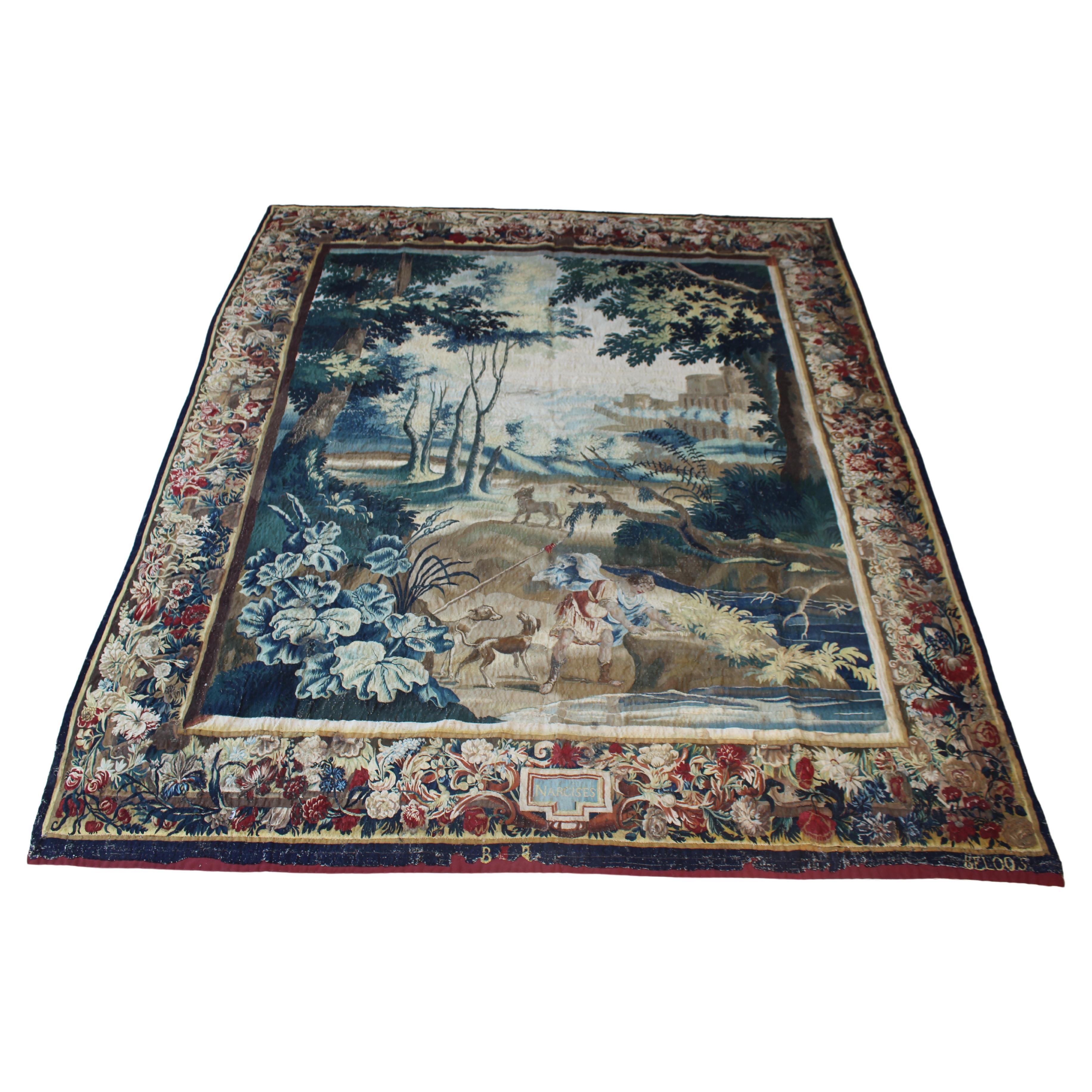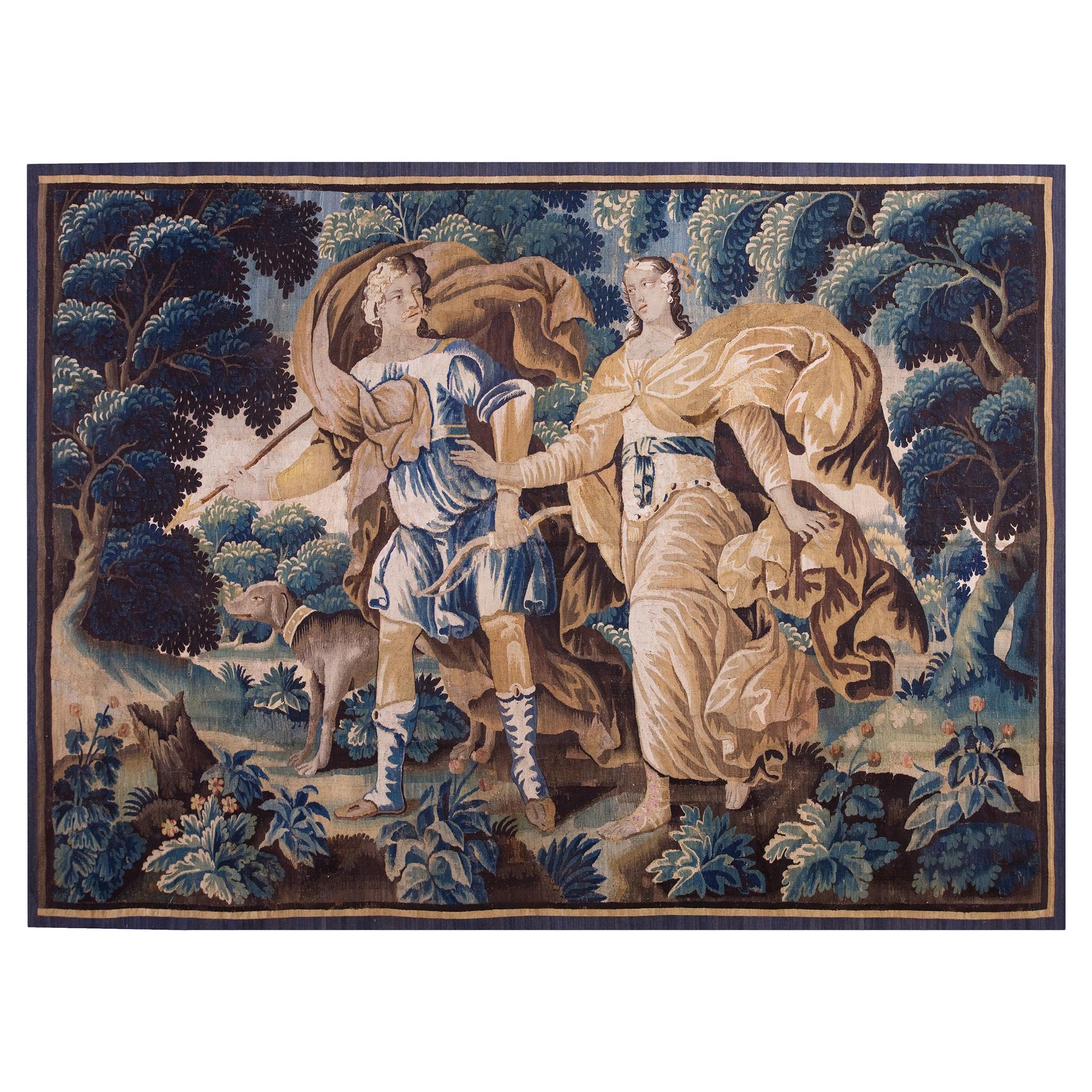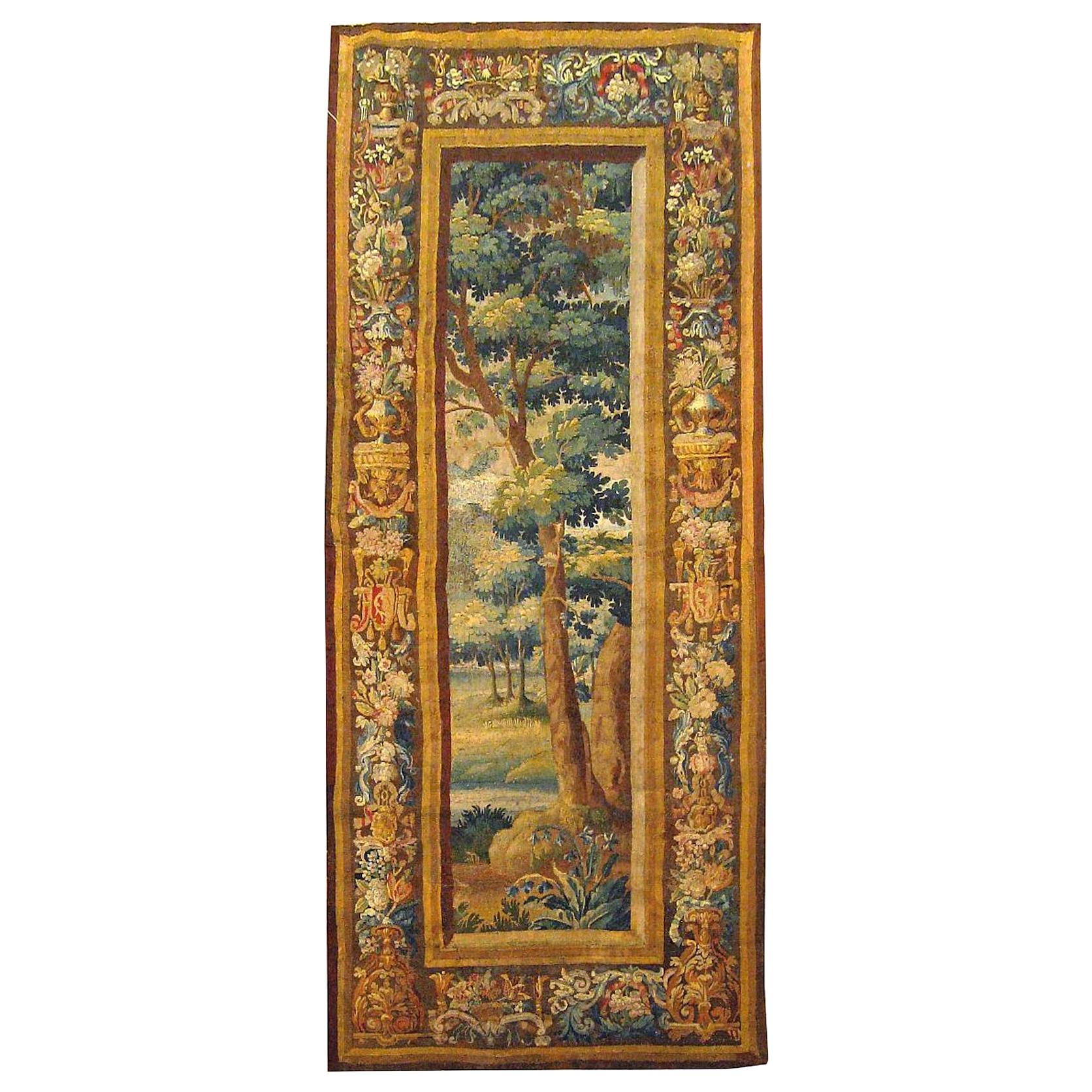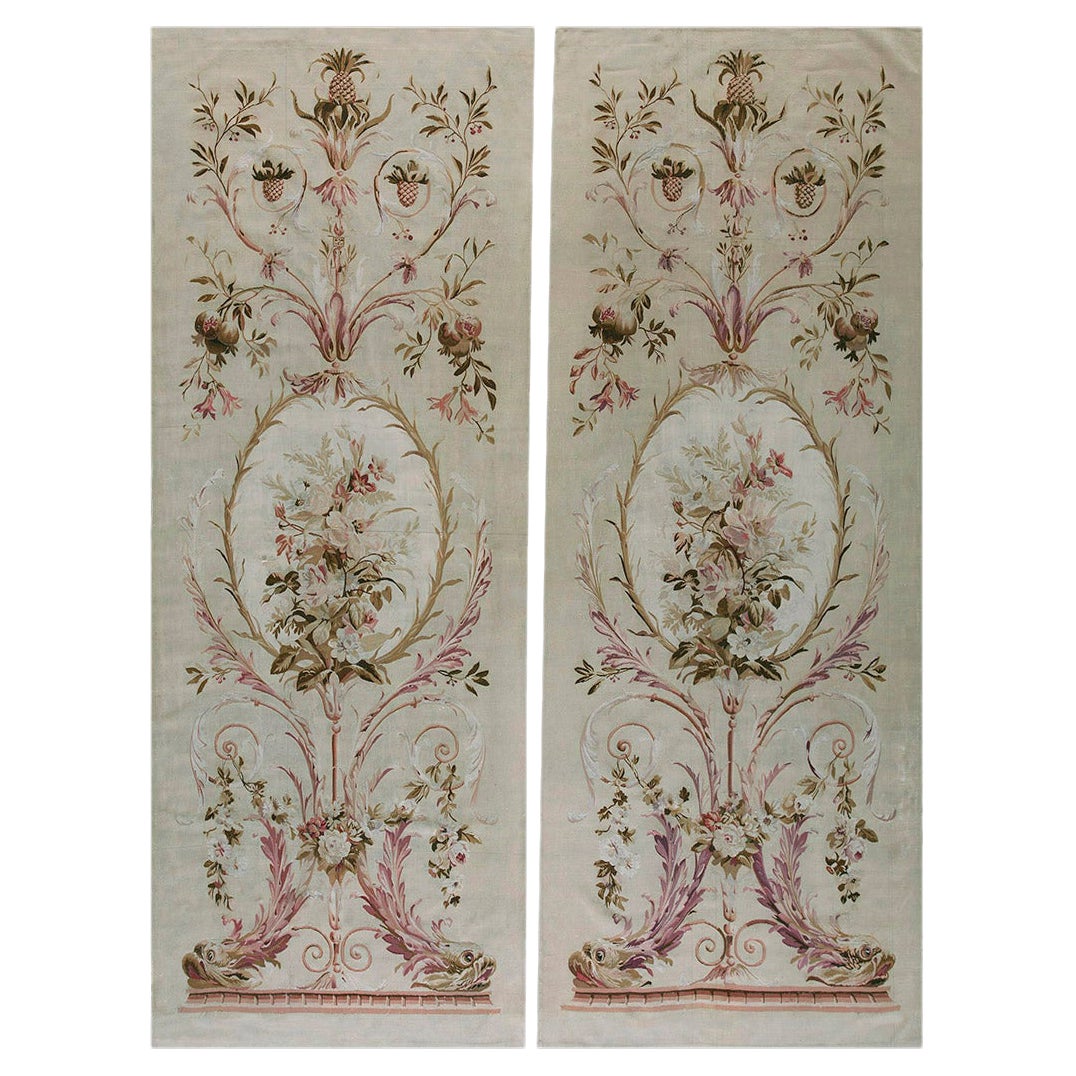Items Similar to 18th Century French Verdure Tapestry ( 9'8" x 10'4" - 295 x 315 )
Want more images or videos?
Request additional images or videos from the seller
1 of 9
18th Century French Verdure Tapestry ( 9'8" x 10'4" - 295 x 315 )
About the Item
18th Century French Verdure Tapestry ( 9'8" x 10'4" - 295 x 315 )
French Verdure Tapestry, Probably Beauvais
Linen warps, wool pattern wefts, tapestry weave,
Width 9.8 by Length 10.4
Third Quarter 18th Century
This is a classic example of the verdure genre popular in 18th century Europe and woven in both France and Flanders. In the placid summer landscape, fully foliaged trees press in from each side to frame a deep vista of a meandering stream and rolling hills. Although the trees are generally generic, the large, gnarled one at the left may be intended to be an oak .The tree on the right could be a laurel. The foreground flowers are centered by a yellow blossomed plant with artichoke-style leaves. This is not a rose although the flowers bear a general resemblance. And the leaves do not resemble rose leaves. An equally yellow tulip grows to the right lower right corner next to what might be intended as a daisy. The wide border displays scroll-edged and an iris (?) sprouts in the three dimensional cartouches (escutcheons), some with textile swags, in the corners and at the midpoints of all four sides. Four escutcheons have grotesque masks as further ornaments. These cartouches show either micro-verdure landscapes or daisy/rose flowers repeating those in the field. These illusionistic cartouches are less common than those displaying armorials. The rose/ daisy motif recurs yet again in the border sections between the escutcheons along with other garden flowers. A French Herbal would allow one to exactly identify the various plants. Bows and ribbons are mixed in with the floral bouquets.
The wide border may be construed as a window frame and the verdure scene may therefore be what is seen through that window. The alternative interpretation is a particularly elaborate polychrome picture frame and the scene as a picture,
As to the origin. There is no town mark in the border. All Brussels and other Flemish tapestries were required to have a town mark after the mid-16th century. French tapestries were not. Certainly, this is not a Gobelins creation. Hence, we must look toward Beauvais, or less likely Aubusson, for the source. The exact designer and workshop requires further study for identification.
Verdures were popular in sizes ranging from two by three meters up to more than three by more than five meters throughout the 18th century, either is suites or as singletons. Our example is a pure forest and landscape vista type with no birds, animals, human habitations or figures.
The colors have held quite well with the yellow, often fugitive in period tapestries, still vibrant in the border and flowers. The various greens, combinations of blue and yellow, have retained their depth and variety.
Overall, this is a well- designed and executed decorative verdure with good colors and unusual border touches from the best period of Beauvais weaving.
- Dimensions:Width: 116 in (294.64 cm)Length: 124 in (314.96 cm)
- Materials and Techniques:Wool,Hand-Knotted
- Place of Origin:
- Period:1780-1789
- Date of Manufacture:1780
- Condition:Rewoven. Repaired.
- Seller Location:New York, NY
- Reference Number:
About the Seller
4.8
Platinum Seller
These expertly vetted sellers are 1stDibs' most experienced sellers and are rated highest by our customers.
Established in 1995
1stDibs seller since 2019
349 sales on 1stDibs
Typical response time: <1 hour
- ShippingRetrieving quote...Ships From: New York, NY
- Return PolicyA return for this item may be initiated within 3 days of delivery.
More From This SellerView All
- 19th Century Chinese Peking Carpet ( 9'8" - 10'4" - 295 x 315 )Located in New York, NY19th Century Chinese Peking Carpet ( 9'8" - 10'4" - 295 x 315 )Category
Antique 1880s Chinese Chinese and East Asian Rugs
MaterialsWool
- Late 17th Century Flemish Biblical Tapestry ( 7'8" x 10'4" - 235 x 315 )Located in New York, NYTapestry, Flemish, Probably Brussels, depicting a scene from the Story of Tobias Late 17th Century -7’ 8” x 10’ 4” - No weaver’s on town mark. Re-bordered in plain stripes; slightl...Category
Antique 1690s Belgian Western European Rugs
MaterialsWool, Silk
- Pair of 19th Century Frnech "Portier" Tapestries ( 7'6" x 10'4" - 230 x 315 )Located in New York, NYPair of 19th Century Frnech "Portier" Tapestries ( 7'6" x 10'4" - 230 x 315 )Category
Antique 1890s French Rococo Revival Western European Rugs
MaterialsWool
- Early 20th Century French Aubusson Carpet ( 9'8" x 10'2" - 295 x 310 cm )Located in New York, NYEarly 20th Century French Aubusson Carpet with Louis XVI Inspired Design ( 9'8" x 10'2" - 295 x 310 cm )Category
Vintage 1920s French Louis XVI Western European Rugs
MaterialsWool
- Mid 18th Century Verdure Tapestry ( 9' 6'' x 14' 4''- 290 x 437 cm )Located in New York, NYMid 18th Century Verdure Tapestry ( 9' 6'' x 14' 4''- 290 x 437 cm )Category
Antique 1750s French Western European Rugs
MaterialsWool
- Mid 19th Century English Needlepoint Carpet ( 8'6" x 9'8"- 260 x 295 )Located in New York, NYMid 19th Century English Needlepoint Carpet ( 8'6" x 9'8"- 260 x 295 )Category
Antique 1860s English Western European Rugs
MaterialsWool
You May Also Like
- 18th century Verdure TapestryLocated in Palm Springs, CA18th century Verdure tapestry measuring approximately 8 by 10 feet. Originally made popular in French courts in the 1600’s They were very popular in the French courts. This example ...Category
Antique 18th Century French French Provincial Western European Rugs
MaterialsFabric
- 18th Century Flemish Verdure TapestryLocated in New York, NYA Flemish verdure landscape tapestry panel from the 18th century, featuring a verdant scene with large trees and various foliage and including a lake. Enclosed within a stylized bord...Category
Antique 18th Century European Tapestries
MaterialsWool
- 18th Century French Aubusson Verdure Landscape TapestryLocated in New York, NYA French Aubusson verdure landscape tapestry from the 18th century, with a crane at the center of the idyllic landscape scene, sitt...Category
Antique 18th Century French Aubusson Tapestries
MaterialsWool
- 18th Century Flemish Verdure Landscape TapestryLocated in New York, NYA Flemish verdure tapestry from the 18th century, depicting two exotic birds within a profuse landscape, with acanthus plants in the foreground, bloomin...Category
Antique 18th Century European Tapestries
MaterialsWool
- 18th Century Verdure Tapestry Fragment RugLocated in New York, NYAuthentic 18th century Verdure Tapestry 'Fragment' rug Size: 7'6" × 11'10" (228 × 360 cm) Although European rugs are in general younger and less diverse than oriental ones, the tapestry making can justly be considered a European specialty. Tracing its origin back to the 18th century Flanders, this antique Verdure tapestry is a true treasure of the Old Continent’s weaving art, permeated with history and beauty. This exceptionally well-preserved fragment exhibits a coherent composition featuring a picturesque landscape of the city suburbs with two herons...Category
Antique Mid-18th Century French Aubusson Western European Rugs
MaterialsWool
- Zabihi Collection Late 18th Century Flemish Verdure TapestryLocated in New York, NYa late 18th century Flemish Vedure Tapestry Measures: 7'4'' wide x 9' long. Tapestries make integral part of the Flemish cultural heritage. Most of the tapestries have religious, m...Category
Antique 18th Century French French Provincial Tapestries
MaterialsWool
Recently Viewed
View AllMore Ways To Browse
Antique European Tapestry
Antique European Tapestries
Antique Tapestry Rugs
Antique Tapestry Rug
Antique Oriental Tapestry
Aubusson Rugs Light Blue
Aubusson Napoleon
Portugal Needlepoint Rug
Portuguese Needlepoint Rugs
Portuguese Needlepoint Rug
Spanish Savonnerie Rug
Spanish Savonnerie
English Needlepoint Carpet
Portuguese Needlepoint Carpet
Savonnerie Royal Carpet
Irish Sheep
English Needlepoint Rugs
English Rug Needlepoint





